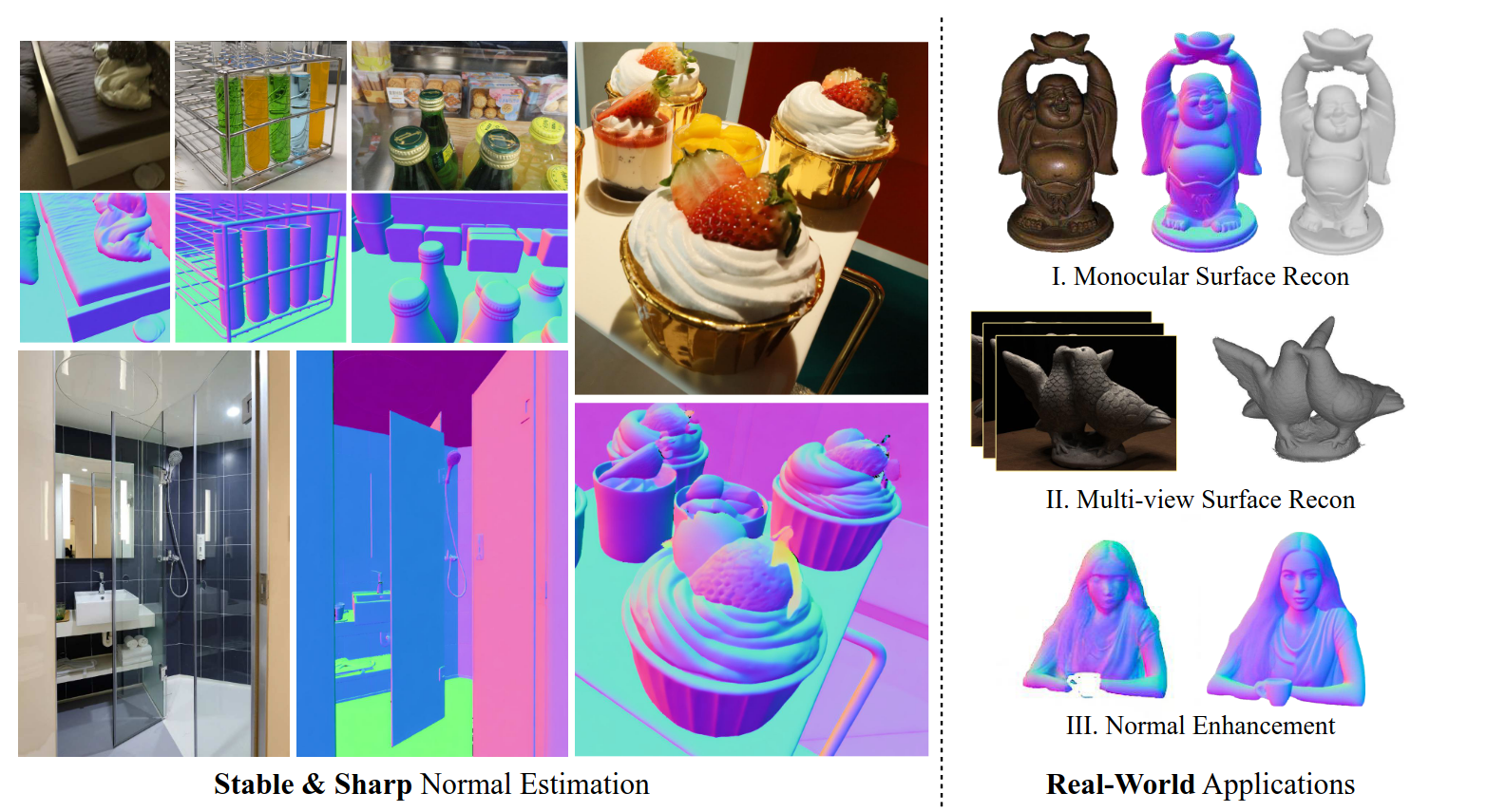Chongjie Ye*, Lingteng Qiu*, Xiaodong Gu, Qi Zuo, Yushuang Wu, Zilong Dong, Liefeng Bo, Yuliang Xiu#, Xiaoguang Han#
* Equal contribution
# Corresponding Author
We propose StableNormal, which tailors the diffusion priors for monocular normal estimation. Unlike prior diffusion-based works, we focus on enhancing estimation stability by reducing the inherent stochasticity of diffusion models ( i.e. , Stable Diffusion). This enables “Stable-and-Sharp” normal estimation, which outperforms multiple baselines (try Compare), and improves various real-world applications (try Demo).
- StableNormal-turbo (10 times faster) is now avaliable on ModelScope . We invite you to explore its features! 🔥🔥🔥 (10.11, 2024 UTC)
- StableNormal is accepted by SIGGRAPH Asia 2024. (Journal Track)) (09.11, 2024 UTC)
- Release StableDelight 🔥🔥🔥 (09.07, 2024 UTC)
- Release StableNormal 🔥🔥🔥 (08.27, 2024 UTC)
Please run following commands to build package:
git clone https://github.com/Stable-X/StableNormal.git
cd StableNormal
pip install -r requirements.txt
or directly build package:
pip install git+https://github.com/Stable-X/StableNormal.git
To use the StableNormal pipeline, you can instantiate the model and apply it to an image as follows:
import torch
from PIL import Image
# Load an image
input_image = Image.open("path/to/your/image.jpg")
# Create predictor instance
predictor = torch.hub.load("Stable-X/StableNormal", "StableNormal", trust_repo=True)
# Apply the model to the image
normal_image = predictor(input_image)
# Save or display the result
normal_image.save("output/normal_map.png")Additional Options:
- If you need faster inference(10 times faster), use
StableNormal_turbo:
predictor = torch.hub.load("Stable-X/StableNormal", "StableNormal_turbo", trust_repo=True)- If Hugging Face is not available from terminal, you could download the pretrained weights to
weightsdir:
predictor = torch.hub.load("Stable-X/StableNormal", "StableNormal", trust_repo=True, local_cache_dir='./weights')Compute Metrics:
This section provides guidance on evaluating your normal predictor using the DIODE dataset.
Step 1: Prepare Your Results Folder
First, make sure you have generated a normal map and structured your results folder as shown below:
├── YOUR-FOLDER-NAME
│ ├── scan_00183_00019_00183_indoors_000_010_gt.png
│ ├── scan_00183_00019_00183_indoors_000_010_init.png
│ ├── scan_00183_00019_00183_indoors_000_010_ref.png
│ ├── scan_00183_00019_00183_indoors_000_010_step0.png
│ ├── scan_00183_00019_00183_indoors_000_010_step1.png
│ ├── scan_00183_00019_00183_indoors_000_010_step2.png
│ ├── scan_00183_00019_00183_indoors_000_010_step3.pngStep 2: Compute Metric Values
Once your results folder is set up, you can compute the metrics for your normal predictions by running the following scripts:
# compute metrics
python ./stablenormal/metrics/compute_metric.py -i ${YOUR-FOLDER-NAME}
# compute variance
python ./stablenormal/metrics/compute_variance.py -i ${YOUR-FOLDER-NAME}Replace ${YOUR-FOLDER-NAME}; with the actual name of your results folder. Following these steps will allow you to effectively evaluate your normal predictor's performance on the DIODE dataset.
Metrics
On DIODE-indoor
| Mean Error | Median Error | <11.25 | <22.5 | <30 | |
|---|---|---|---|---|---|
| GeoWizard | 19.371 | 15.408 | 30.551 | 75.426 | 86.357 |
| Marigold Normal | 16.671 | 12.084 | 45.776 | 82.076 | 89.879 |
| GenPercept | 18.348 | 13.367 | 39.178 | 79.819 | 88.551 |
| DSINE | 18.453 | 13.871 | 36.274 | 77.527 | 86.976 |
| StableNormal-turbo | 16.748 | 13.573 | 35.806 | 84.585 | 91.335 |
| StableNormal | 13.701 | 9.460 | 63.447 | 86.309 | 92.107 |
On IBims-1
| Mean Error | Median Error | < 11.25 | < 22.5 | < 30 | |
|---|---|---|---|---|---|
| GeoWizard | 19.748 | 9.702 | 58.427 | 77.616 | 81.575 |
| Marigold Normal | 18.463 | 8.442 | 64.727 | 79.559 | 83.199 |
| GenPercept | 18.600 | 8.293 | 64.697 | 79.329 | 82.978 |
| DSINE | 18.773 | 8.258 | 64.131 | 78.570 | 82.160 |
| StableNormal-turbo | 17.433 | 8.145 | 65.683 | 80.909 | 84.527 |
| StableNormal | 17.248 | 8.057 | 66.655 | 81.134 | 84.632 |
On Scannet
| Mean Error | Median Error | < 11.25 | < 22.5 | < 30 | |
|---|---|---|---|---|---|
| GeoWizard | 21.439 | 13.390 | 37.080 | 71.653 | 79.712 |
| Marigold Normal | 21.284 | 12.268 | 45.649 | 72.666 | 79.045 |
| GenPercept | 20.652 | 10.502 | 53.017 | 74.470 | 80.364 |
| DSINE | 18.610 | 9.885 | 56.132 | 76.944 | 82.606 |
| StableNormal-turbo | 17.432 | 9.644 | 58.643 | 79.177 | 84.717 |
| StableNormal | 18.098 | 10.097 | 56.007 | 78.776 | 84.115 |
On NYUv2
| Mean Error | Median Error | < 11.25 | < 22.5 | < 30 | |
|---|---|---|---|---|---|
| GeoWizard | 20.363 | 11.898 | 46.954 | 73.787 | 80.804 |
| Marigold Normal | 20.864 | 11.134 | 50.457 | 73.003 | 79.332 |
| GenPercept | 20.896 | 11.516 | 50.712 | 73.037 | 79.216 |
| DSINE | - | - | - | - | - |
| StableNormal-turbo | 18.788 | 10.381 | 53.741 | 76.713 | 82.884 |
| StableNormal | 19.707 | 10.527 | 53.042 | 75.889 | 81.723 |
@article{ye2024stablenormal,
title={StableNormal: Reducing Diffusion Variance for Stable and Sharp Normal},
author={Ye, Chongjie and Qiu, Lingteng and Gu, Xiaodong and Zuo, Qi and Wu, Yushuang and Dong, Zilong and Bo, Liefeng and Xiu, Yuliang and Han, Xiaoguang},
journal={ACM Transactions on Graphics (TOG)},
year={2024},
publisher={ACM New York, NY, USA}
}




